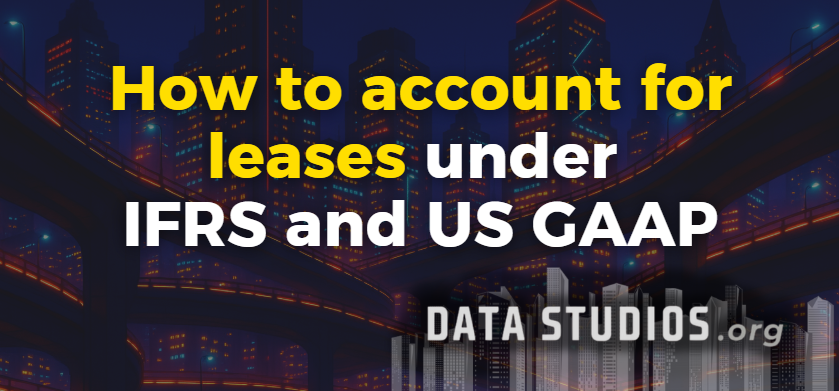How to account for leases under IFRS and US GAAP: Recognition, measurement, and disclosure
- Graziano Stefanelli
- Sep 13
- 3 min read

Leasing is a core financing strategy for many organizations, enabling access to assets without immediate ownership. The accounting for leases significantly influences balance sheets, income statements, and key financial ratios. Both IFRS (IFRS 16) and US GAAP (ASC 842) require lessees to recognize most leases on the balance sheet, but they differ in classification, expense recognition, and disclosure requirements. Understanding these differences is essential for accurate financial reporting and for comparing results across jurisdictions.
Most leases are recognized on the balance sheet under both IFRS and US GAAP.
IFRS 16 requires lessees to recognize a right-of-use (ROU) asset and a corresponding lease liability for nearly all leases with a term longer than 12 months, unless the underlying asset is of low value. At commencement, the ROU asset is measured at cost (including initial direct costs, prepaid lease payments, and estimated restoration obligations), and the liability equals the present value of lease payments not yet paid.
US GAAP (ASC 842) similarly requires lessees to recognize an ROU asset and a lease liability for most leases, but distinguishes between finance leases (similar to capital leases under the previous ASC 840) and operating leases. Both types are on the balance sheet, but expense recognition differs.
Aspect | IFRS 16 | US GAAP (ASC 842) |
Scope | All leases (few exceptions) | All leases (few exceptions) |
ROU asset and liability | Recognized for all, unless exempt | Recognized for finance/operating |
Short-term/low value | Exempt, can elect not to recognize | Exempt (short-term only, <12 months) |
Initial and subsequent measurement of lease assets and liabilities.
Initial measurement for both frameworks is similar:
Lease liability: Present value of future lease payments, discounted at the rate implicit in the lease or lessee’s incremental borrowing rate.
ROU asset: Includes lease liability, initial direct costs, prepayments, less lease incentives received.
Subsequent measurement diverges:
IFRS 16: ROU asset is depreciated, and lease liability is unwound using the effective interest method. All leases result in a front-loaded expense pattern on the income statement.
US GAAP (ASC 842): Finance leases follow the same expense recognition as IFRS 16, with interest and amortization presented separately. Operating leases, however, present a single lease expense on a straight-line basis, combining interest and amortization for income statement purposes.
Expense pattern | IFRS 16 | US GAAP (ASC 842) |
Finance/capital lease | Depreciation + interest | Amortization + interest |
Operating lease | Same as finance lease | Single lease expense, straight-line |
Lease classification and exemptions.
IFRS 16 eliminates lease classification for lessees—all leases are treated similarly, with exemptions for short-term leases (≤12 months) and low-value assets (e.g., laptops, phones).
US GAAP (ASC 842) retains a dual classification:
Finance leases: Substantially all risks and rewards of ownership transfer to the lessee.
Operating leases: Do not meet finance lease criteria, but are still on the balance sheet. Expense is presented as a single operating expense.
Lessors continue to classify leases as operating or sales-type/direct financing under both frameworks, with more technical distinctions in US GAAP.
Measurement of variable payments, options, and reassessments.
Variable lease payments based on usage or sales are generally not included in the initial measurement of lease liability (unless they depend on an index or rate).
Options to extend or terminate: Included in lease term if reasonably certain to be exercised.
Reassessment: Both standards require lease liability and ROU asset to be remeasured if key lease terms change, such as modifications, exercise of options, or changes in payment indices.
Disclosure requirements and presentation.
IFRS 16 and US GAAP (ASC 842) both require extensive disclosures to enhance transparency:
Disclosure area | IFRS 16 | US GAAP (ASC 842) |
ROU asset and lease liability | Separate presentation or in notes | Separate or included in PPE/other liabilities |
Maturity analysis of lease liabilities | Required | Required |
Expense breakdown (interest, amortization, short-term, low value, variable) | Required | Required |
Qualitative disclosures (leases not yet commenced, extension options, restrictions) | Required | Required |
Cash flow information | Separate cash flow presentation | Separate (operating/financing) |
Key differences and practical impacts for lessees.
Feature | IFRS 16 | US GAAP (ASC 842) |
Lessee lease classification | None (all on balance sheet, same treatment) | Finance/operating distinction, both on balance sheet |
Income statement impact | All leases have front-loaded expense | Finance: front-loaded, Operating: straight-line |
Low-value asset exemption | Permitted | Not permitted |
Reassessment requirements | Broader, more frequent | More restrictive |
Lessor accounting | Similar to previous IAS 17 | Similar to previous ASC 840 |
Careful contract analysis, accurate discount rate selection, and robust tracking of lease modifications are essential for compliance under both IFRS and US GAAP. The new rules have increased transparency but require greater judgment and disclosure than previous standards. ____________
FOLLOW US FOR MORE.
DATA STUDIOS




